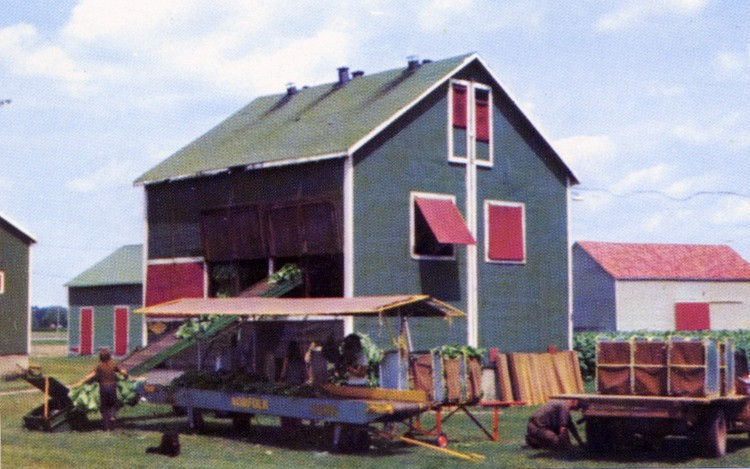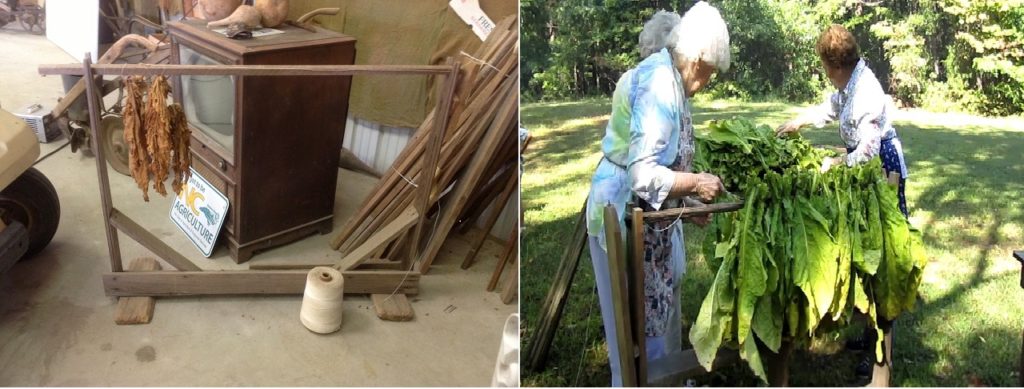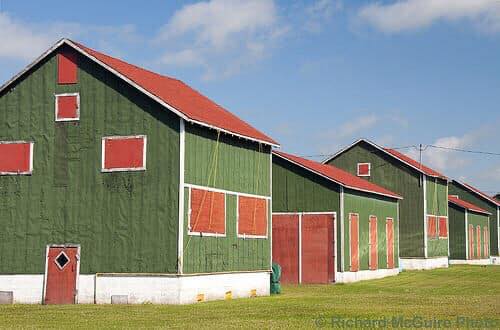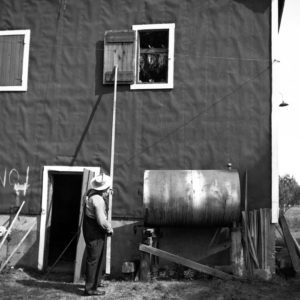Hanging kiln

A good segment of my growing years were spent in the presence of tobacco. My father was a 1.5- to 2-pack per day smoker and smoking appeared to be ubiquitous in the southwestern Ontario of the 1950s and 1960s. Everyone seemed to know smoking wasn’t “good for you” and yet there wasn’t either the overwhelming evidence against tobacco use or the stigma attached to it then as now. In late high school, I remember having to do a health project on smoking behaviour; my task was to interview 10 people about smoking; I don’t know if the questions were pre-formed but I do remember there was a raise health-awareness agenda to the class projects. The tenth person I interviewed was my dad and I was keenly aware, all-knowing teen that I was, that very likely I could convince him to see the error of his smoking ways. I said to him right at the outset, “dad, don’t you know if you quit smoking you’d live longer?” His answer was immediate and unequivocal when he said softly and confidently, “No, life would just seem longer.” He wasn’t being a smart-ass or witty; it was a cogent expression of what smoking behaviour meant to him and it rocked me backward and perhaps even made me appreciate who he was despite my belief system around tobacco use. To my father, smoking was a major part of his world, in the Air Force, in his social circles, even in the rituals of extracting a cigarette from its package, tapping the non-filtered end on the cigarette pack, inserting the stick in his mouth, and then deftly flicking his silver lighter open to ignite the tobacco-end. Perhaps it relaxed him, perhaps he enjoyed it; perhaps and very likley, he was addicted to nicotine. Nonetheless, he chose to smoke and all of the nuances of smoking and his relationships attached to that behaviour cemented the habit in his way of being.
Spending most summers of my youth and my teen years on a farm (described elsewhere) in the tobacco belt of Norfolk county inevitably meant that tobacco would touch my life. And it did, profoundly in so many ways. My grandparents worked in tobacco; my grandfather built kilns or tobacco barns wherein the leaves were stored, cured, and then packed into bales for auction – the latter mostly in Delhi – then processing, then distribution as various products to be marketed by commercial tobacco companies. I remember going with my grandpa when he constructed kilns and at lunch time, marvelling at his penchant for eating a whole tomatoe in the same way one would eat an apple and with each bite, he salted the tomatoe to his taste.
My grandmother ‘handed leaves’ during harvest; this meant standing for hours at a wagon-table like the one in the picture above, and grabbing tobacco leaves by the stems, three-at-a-time and then handing each packet leafy parts pointing downward to a person at the tying horse (see the images below). This tyer was highly regarded and very skilled at taking leaves from several handlers, setting the stems against a flat piece of wood about a yard long, half an inch in width and thickness and affixing the stems using twine, fed from a huge spool, by deftly wrapping the string around the stems. Care had to be taken not to cut the leaves and to place each bundle of handed-leaves just far enough apart to permit full and even curing of the leaves once hung in the kiln. It was rhythmic to watch the tyer grabbing the bunched leaves, with heavily black-taped fingers else suffer perpetual twine-cuts, from the handlers, rocking gently forth and back, taking baby-steps in reverse down the length of the stick, every other leaf bundle flipped to the other side of the stick until reaching near the end and tying off the stick with a special knot. Both ends of the stick were left empty for about 6 inches of space in order to suspend the sticks in the kiln for curing. Leaf-handlers took the completed stick and placed it on a conveyor belt going up through an open shutter-window into the kiln (see the conveyance method in the first picture in this blog).

My Uncle ‘Cobe’ Hall was a tobacco tyer and one of my idols when I was first coerced by my father – “it will be good for the boy” – into working in tobacco harvest the summer between grades seven and eight at Exeter Public School. Another uncle, Lloyd Hall had just purchased a tobacco farm and my grandmother and I went to work for him, she and I sleeping in the same room for 4-5 weeks starting August 12th – my Gram proclaimed that every tobacco harvest-year started on that day, her birthday. My cousin Brad, a year or more younger, had been taught to drive the farm station-wagon and I managed to convince Brad it was only fitting that I learn too. Driving around the dirt roads of the farm fields in the light-green Ford station wagon was one of the few thrills I experienced that summer. My job was to “hang kiln” and the prospect, once explained to me, kept me awake nights in abject fear.

So innocent-looking in their rows, kilns that cured leaves that killed.
Kilns looked harmless on the outside. On the inside, covering most of the circumference of the dirt ground was the heater, an oil-burning furnace, octopus-like in the 6-8 pipe arms extending around the core of the heater. Otherwise the barn was empty with just tiers of ascending rafters – perhaps 8-10 levels – on which to hang the finished sticks of tied tobacco leaves. The kiln was loaded from the top down. Kiln hangers like me, set up portable two-by-fours, perhaps 3 or 4 of them going from the centre to the wall across the beams or rafters on one side of the kiln about 3 rows from the top, moving the two-by-fours down to the next level as the top rows were filled. The conveyor belt was set to deliver the sticks about waist height. Wearing rubber boots and old clothes, my job was to take each leaf-loaded stick from the belt, carry it to the back, and starting at the top-most tier, hang them parallel to each other. In theory, it was a tried and true system; in practice, the tier rows were warped and in the act of trying to sling each stick to rest on its leaf-empty ends, I dropped way too many sticks, a great source of frustration for the leaf-handlers and tyers, not to mention potential damage to the leaves, the bread and butter of tobacco farmers.
Harvest days started very early, usually 6:30 in the morning with the goal to fill the kiln as quickly as possible to end the work-day. Picking the leaves or priming was back-breaking work wherein the primers, usually 6 men often migrant or itinerant workers from Quebec or Jamaica, in the first days of harvest, started picking from the bottom or sand-leaves of each stalk. The early start meant the first leaves were soaking wet usually from dew and often from rain and the pickers had to wear full rain-pants and coats as well as boots. Walking down the plant-rows bent over, the primers picked 3-4 leaves with one hand in a kind of finger-collecting coil of each stalk, swept the leaves under the other arm and continued to the next plants. Once each primer had an armful, they would stand upright and crossing rows, place the leaves into a tobacco ‘boat.’ The boat was a long-narrow, wooden structure on sleigh-runners, pulled – at least during the time I worked in tobacco – by a horse, Clydesdales usually, beautiful draft animals that I adored, down the length of the row. Once filled, the primers pulled and tied a tarp over the top of the leaves, stacked somewhat higher than the sides of the boat, in order to prevent leaves from falling out during transport back to the kiln. This video captures the process of loading the boats, transporting them via a tractor and trailer during the 1960s when I worked in the industry.
For the hanger, me, wet leaves meant I too wore rubber boots; the two-by-fours quickly became wet and treacherous, and handling the sticks of water-laden leaves was awkward to say nothing of carrying the sticks to the back wall of the kiln and then lifting them up to the topmost tiers. And it was a race to hang each stick and get back to the perpetually running conveyor belt to grab the next stick before it fell to the floor, an all-too frequent occurrence during my kiln-hanging debut days. At 11 years old, I was short and had great difficulty getting the sticks, resting one end on a tier and using my free hand to help climb up on one tier to reach the top tiers then flip the far end of the stick across the rafters. For about a week or ten days, Uncle Cobe, cigarette stub perpetually suspended from his lips, had to come up into the kiln in the mornings to assist me in loading the top-most rows. Each kiln was loaded by quarters of the barn, top to bottom, except the hanger had to do the top 3 rows of the conveyor belt side of the kiln actually straddling the conveyor because the windows would not permit the belt to come up that high on the near side of the barn. That meant straddling the conveyer belt and kind of scuttling hurriedly along two rafters – more dropped sticks, more help needed from Cobe who seemed to be spider-like in his ability to handle the sticks and navigate the rafters stunningly sans two-by-fours.

Eventually, I became more adept at the art and science of hanging kiln. However, near tragedy happened about the third day of my tobacco harvesting apprenticeship – I slipped on one of the two-by-fours and fell from one of the top rows; somehow I missed hitting any of the rafters during my descent, and landed on the as yet unlit burner pipes smacking the back of my head on one pipe tentacle. It was probably about a 30-40-foot drop and my guess is the pliable pipes actually cushioned the impact of my fall. I remember everyone rushing in, checking me for injuries and then declaring I must have a hard head inherited from my father. When dad was young, 7 or 8 I think, he was standing on the side running board of a car driving at normal speed on some road on route to or from pea-picking somewhere. His straw hat – a boater straw hat in my imagination – blew off and I guess he thought he could just step off the runner, retrieve his hat, and get back on. From all accounts, the instant he left the car, he was momentum- and gravity-propelled onto his back first striking the ground with his head. Apparently he was unconscious for a while and the injury was serious enough that they were concerned he wouldn’t recover fully. He did and the incident was recalled by my uncles when I had my kiln mishap.
The fall prompted my Uncle Lloyd to repair the warped rafters in each kiln – about 7 or 8 of them on his farm – and supply a long, wide board to run over top of the two-by-fours to make my steps less precarious. The other big part of hanging kiln was doing it properly such that the leaves cured evenly. That meant the sticks had to be equidistantly placed, with space left at the walls and centre, horizontal beams to permit the heat to rise unobstructed through the suspended leaves. My whole focus was just getting the sticks on the rafters, spilling as few as possible, and not falling – curing the leaves was just not on my radar. The farm-hand charged with the responsibility for full and proper curing was a curious, quiet man everyone called Sat. Sat, perpetually sporting a well-worn, black fedora, pants held up by suspenders, was from the southern states, maybe Virginia or one of the other tobacco-growing areas, and he was the acknowledged expert in converting freshly hung leaves to accurately cured ones ready for auction.

Sat is not the man in the image above but the photo does represent the kind of work the tobacco curers had to do. Tending kiln was a 24-hour job, adjusting the temperatures, opening or closing vents, repeated testing of the leaves until properly cured – perhaps a week or more, I don’t remember – and the kiln could be unloaded and readied for the next refilling. Sat was adamant in telling me how to hang the sticks and angered, at times, by having to compensate for my transgressions – “the boy,” he said “makes the leaves burn black as your hat” when golden-yellow was the coveted hue. The resolution was for my uncle and a cadre of the primers and other farm-hands to cut up tobacco sticks into 8-10 inch pieces and then nail them flat along the length of all of the rafters in all the kilns, leaving a stick-width between each piece in order for me to get the leaf-laden sticks into the slot, properly spaced to Sat’s satisfaction. Heights terrified me, still do, but the new board system and the slots along the rafters meant relative safety and proper hanging of the kiln such that my task became an everyday physical, almost athletic challenge to get better and better.
The daily pay for working in tobacco, especially for a student was unbelievably good. As I continued in tobacco harvest through most of my high school years, unlike my friends who had to have all-summer long jobs, I got to play tennis on Beck Collegiate’s courts across from our London home and indulge in endless card games of euchre or hearts in the evenings with my core group of friends until early August. And I still cleared more money than most students who worked at full summer jobs.
I hung kiln for 2 summers but my draw was to become a boat-driver, the person who drove a tractor pulling a double-boat trailer to the fields being primed to drop off empty boats, one at each end of the plant rows and pick up the filled boats to transport them back to the kiln. I switched working farms after grade nine, living at my Gram’s farm about two miles from a tobacco farm owned by a very kind man, Roger, a friend of my grandparents who had bought most of their farm-land, secondary to his original property to add acreage to his arable land. I never was involved in planting tobacco but when Roger hired me, I came 7-10 days before harvest to help move large irrigation pipes among the rows or ‘top’ the plants – snapping the vertical, often flowering crest of the stalks that were sucking nutrients from the plant-base – then suckering the plants by squirting a liquid concoction down the core of each plant to get at and kill all the suckers at each leaf-junction. Handling tobacco plants, leaves, and stems stained everyone’s hands for which most farms stocked Swarfega, a green-coloured, chemical gel hand-cleaner that we used liberally before lunch and at end of the work-day.
At 14, I had to get a special farm-related license from the provincial Ministry of Transportation because driving the tractor to and from the two farms necessitated driving along the Turkey Point Road. I relished the job. Roger let me park his red diesel tractor under the corn crib roof at my Gram’s farm so that I could commute to the central farm every day. Often I was alone on the farm for days or weeks if my grandmother were working on and boarding at a farm too far for her to come back to her house. I suspect a spin-off from driving boats was the actual driving skills I learned. Backing the roller-based boat-trailer was an art akin to backing any hinged trailer on any vehicle; however, the back-end of the trailer and end-most roller had to be backed under the sled-like legs of the boat until the boat was about 2/3 on the trailer and then, affixing a metal ring on a thick-wire pulley to a hook on the boat, one had to hand-crank the boat fully onto the trailer. And then, even more challenging, was picking up the second boat and getting it on the trailer rollers beside the first one. Primers, over-worked and likely bored, loved to put the boats in the most awkward position, making them hard work to retrieve and load, and a great source of amusement for them to watch. It was unspoken fun, just part of being a driver.
Every year, I stayed til the end of harvest, often into mid September which meant I was always two weeks late coming back to high school. When harvest was completed at one farm, I often was hired by other farms to finish their crops before the first frost or a hail storm – both the arch-enemies of tobacco farmers – ended the season. The last two rows or tips of the tobacco plant were gravy to the farmers, where their profit was made and they paid well for extra help in priming, hanging kiln, driving etc. Oddly, in all my years working in tobacco, I never associated it with the deadly impact tobacco products might have on a population. And my intent is not to privilege or glorify tobacco in any way. It was just a crop to me, part of farming, itself an occupation that enchanted me enough to consider farming a livelihood. And there was romance in working in tobacco, literally when my first real girlfriend was the farmer’s daughter but more metaphorically in the culture of harvest – hard working days; body conditioning itself to the physical demands; endless pranks and jokes among workers; lunch-time feasts for all farm-hands, an avalanche of food; the freedom of living on my own at a relatively young age; making such good money that often my father borrowed from me, paying me back when he could – wonder-ful summers in my life. And always, in all ways when I think of those carefree days, I tumble home to hanging kiln, even to the memory of tumbling in a kiln.
